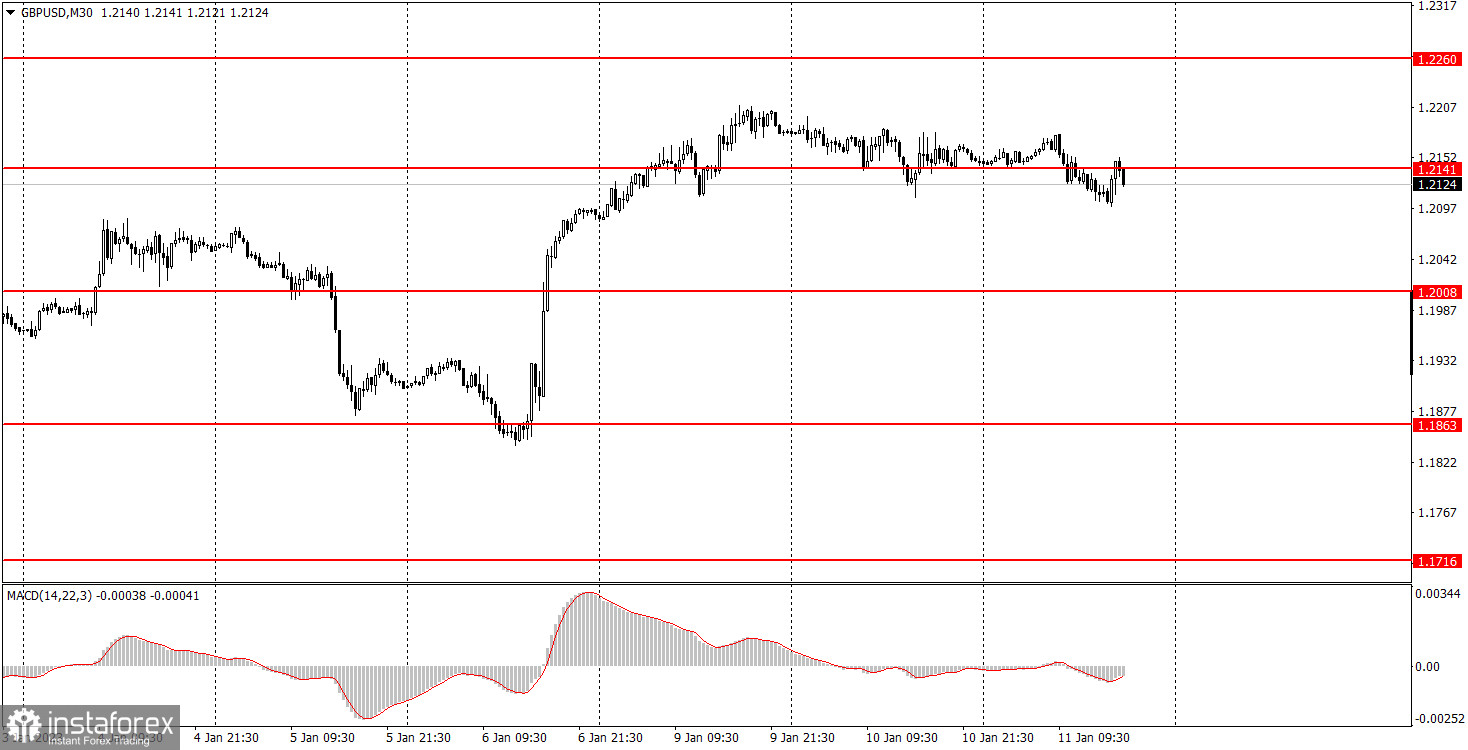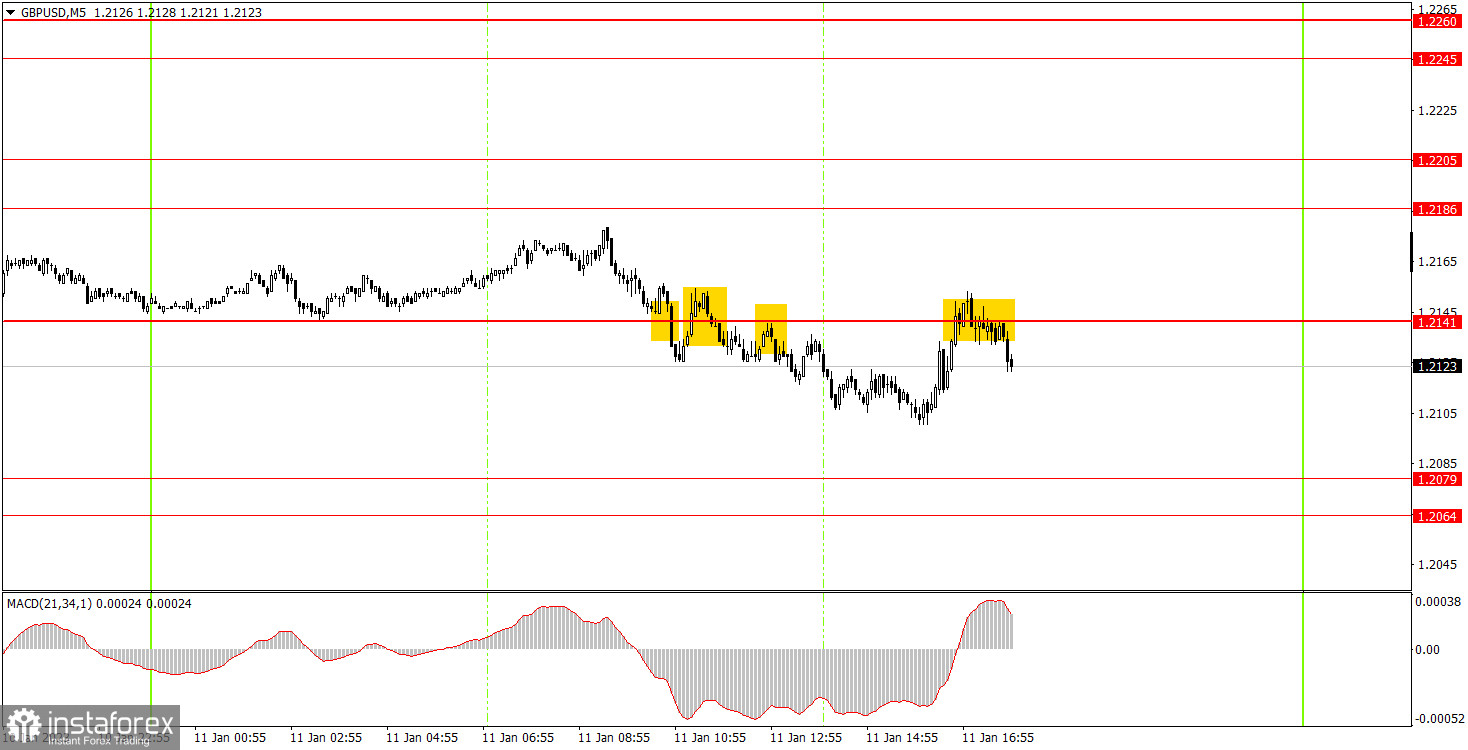Analyzing Wednesday's trades:
GBP/USD on 30M chart

GBP/USD was trying to continue its downward movement all day long. No fundamental and macroeconomic backgrounds on Wednesday, traders had nothing to react to, and volatility was low at about 80 pips. Today the pair managed to settle below 1.2141, so it got the formal grounds for continuing the downward movement. At the same time, the movement from the last few days appears flat-like, so a continuation of the pound's decline seems far off. And even if it does, it is very difficult to make profit from it since the direction of the movement is not the only thing that matters, but also the nature of its movement. It is very difficult to make a profit during a flat. In general, the pound's movement has made more sense than the euro, so it has more chances to move down. But the US inflation report will be released on Thursday, which may have a strong influence on traders' sentiment.
GBP/USD on M5 chart

All of the trading signals were formed near 1.2141 and all of them turned out to be false. Also, as in the case with the euro, novice players could work out the first two signals. In the first case, the price failed to go down 20 pips, but it also failed to move back above 1.2141 too. All the rebounds and breakthroughs were not accurate. The second and third signals simply duplicated the first one, so at the time of their formation the first short position should have been opened. As a result, the price went down about 30 points, which was enough for the Stop Loss to breakeven, on which the trade was closed, as the price returned to 1.2141 at the US session.
Trading tips on Thursday:
On the 30-minute chart, GBP/USD went up again last Friday, which does not correspond to the macroeconomic background that was available for traders. I don't think the pair's growth is logical, we're just waiting for a new round of decline. Also, this week, the market could realize that the dollar's decline on Friday was unfair, and maybe then GBP will finally start falling. On the 5-minute chart, it is recommended to trade at the levels 1.1950-1.1957, 1.2008, 1.2057-1.2079, 1.2141, 1.2186-1.2205, 1.2245-1.2260, 1.2337-1.2343. As soon as the price passes 20 pips in the right direction, you should set a Stop Loss to breakeven. There are no important events scheduled for Thursday in the UK, but the US will publish an important inflation report, which could very much influence the course of trading. It will be released in the afternoon and it is impossible to predict the reaction to it.
Basic rules of the trading system:
1) The strength of the signal is determined by the time it took the signal to form (a rebound or a breakout of the level). The quicker it is formed, the stronger the signal is.
2) If two or more positions were opened near a certain level based on a false signal (which did not trigger a Take Profit or test the nearest target level), then all subsequent signals at this level should be ignored.
3) When trading flat, a pair can form multiple false signals or not form them at all. In any case, it is better to stop trading at the first sign of a flat movement.
4) Trades should be opened in the period between the start of the European session and the middle of the US trading hours when all positions must be closed manually.
5) You can trade using signals from the MACD indicator on the 30-minute time frame only amid strong volatility and a clear trend that should be confirmed by a trendline or a trend channel.
6) If two levels are located too close to each other (from 5 to 15 pips), they should be considered support and resistance levels.
On the chart:
Support and Resistance levels are the levels that serve as targets when buying or selling the pair. You can place Take Profit near these levels.
Red lines are channels or trend lines that display the current trend and show in which direction it is better to trade now.
The MACD indicator (14, 22, and 3) consists of a histogram and a signal line. When they cross, this is a signal to enter the market. It is recommended to use this indicator in combination with trend patterns (channels and trendlines).
Important announcements and economic reports that can be found on the economic calendar can seriously influence the trajectory of a currency pair. Therefore, at the time of their release, we recommend trading as carefully as possible or exiting the market in order to avoid sharp price fluctuations.
Beginners on Forex should remember that not every single trade has to be profitable. The development of a clear strategy and money management is the key to success in trading over a long period of time.
 English
English 
 Русский
Русский Bahasa Indonesia
Bahasa Indonesia Bahasa Malay
Bahasa Malay ไทย
ไทย Español
Español Deutsch
Deutsch Български
Български Français
Français Tiếng Việt
Tiếng Việt 中文
中文 বাংলা
বাংলা हिन्दी
हिन्दी Čeština
Čeština Українська
Українська Română
Română

